Normalized difference vegetation index
The normalized difference vegetation index (NDVI) is a widely-used metric for quantifying the health and density of vegetation using sensor data. It is calculated from spectrometric data at two specific bands: red and near-infrared. The spectrometric data is usually sourced from remote sensors, such as satellites.
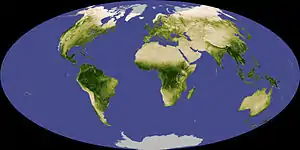
The metric is popular in industry because of its accuracy. It has a high correlation with the true state of vegetation on the ground. The index is easy to interpret: NDVI will be a value between -1 and 1. An area with nothing growing in it will have an NDVI of zero. NDVI will increase in proportion to vegetation growth. An area with dense, healthy vegetation will have an NDVI of one. NDVI values less than 0 suggest a lack of dry land. An ocean will yield an NDVI of -1.[2]
Brief history
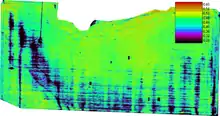
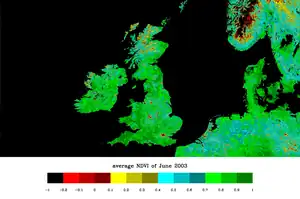
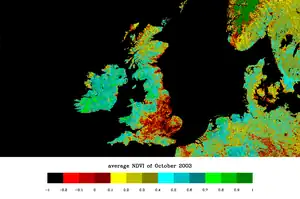

The exploration of outer space started in earnest with the launch of Sputnik 1 by the Soviet Union on 4 October 1957. This was the first man-made satellite orbiting the Earth. Subsequent successful launches, both in the Soviet Union (e.g., the Sputnik and Cosmos programs), and in the U.S. (e.g., the Explorer program), quickly led to the design and operation of dedicated meteorological satellites. These are orbiting platforms embarking instruments specially designed to observe the Earth's atmosphere and surface with a view to improve weather forecasting. Starting in 1960, the TIROS series of satellites embarked television cameras and radiometers. This was later (1964 onwards) followed by the Nimbus satellites and the family of Advanced Very High Resolution Radiometer instruments on board the National Oceanic and Atmospheric Administration (NOAA) platforms. The latter measures the reflectance of the planet in red and near-infrared bands, as well as in the thermal infrared. In parallel, NASA developed the Earth Resources Technology Satellite (ERTS), which became the precursor to the Landsat program. These early sensors had minimal spectral resolution, but tended to include bands in the red and near-infrared, which are useful to distinguish vegetation and clouds, amongst other targets.
With the launch of the first ERTS satellite – which was soon to be renamed Landsat 1 – on July 23, 1972 with its MultiSpectral Scanner (MSS) NASA funded a number of investigations to determine its capabilities for Earth remote sensing. One of those early studies was directed toward examining the spring vegetation green-up and subsequent summer and fall dry-down (the so-called “vernal advancement and retrogradation”) throughout the north to south expanse of the Great Plains region of the central U.S. This region covered a wide range of latitudes from the southern tip of Texas to the U.S.-Canada border, which resulted in a wide range of solar zenith angles at the time of the satellite observations.
The researchers for this Great Plains study (PhD student Donald Deering and his advisor Dr. Robert Hass) found that their ability to correlate, or quantify, the biophysical characteristics of the rangeland vegetation of this region from the satellite spectral signals was confounded by these differences in solar zenith angle across this strong latitudinal gradient. With the assistance of a resident mathematician (Dr. John Schell), they studied solutions to this dilemma and subsequently developed the ratio of the difference of the red and infrared radiances over their sum as a means to adjust for or “normalize” the effects of the solar zenith angle. Originally, they called this ratio the “Vegetation Index” (and another variant, the square-root transformation of the difference-sum ratio, the “Transformed Vegetation Index”); but as several other remote sensing researchers were identifying the simple red/infrared ratio and other spectral ratios as the “vegetation index,” they eventually began to identify the difference/sum ratio formulation as the normalized difference vegetation index. The earliest reported use of NDVI in the Great Plains study was in 1973 by Rouse et al.[4] (Dr. John Rouse was the Director of the Remote Sensing Center of Texas A&M University where the Great Plains study was conducted). However, they were preceded in formulating a normalized difference spectral index by Kriegler et al. in 1969.[5] Soon after the launch of ERTS-1 (Landsat-1), Compton Tucker of NASA's Goddard Space Flight Center produced a series of early scientific journal articles describing uses of the NDVI.
Thus, NDVI was one of the most successful of many attempts to simply and quickly identify vegetated areas and their "condition," and it remains the most well-known and used index to detect live green plant canopies in multispectral remote sensing data. Once the feasibility to detect vegetation had been demonstrated, users tended to also use the NDVI to quantify the photosynthetic capacity of plant canopies. This, however, can be a rather more complex undertaking if not done properly, as is discussed below.
Rationale
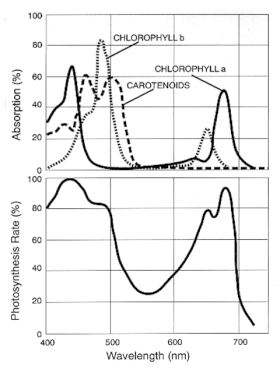
Live green plants absorb solar radiation in the photosynthetically active radiation (PAR) spectral region, which they use as a source of energy in the process of photosynthesis. Leaf cells have also evolved to re-emit solar radiation in the near-infrared spectral region (which carries approximately half of the total incoming solar energy), because the photon energy at wavelengths longer than about 700 nanometers is too large to synthesize organic molecules. A strong absorption at these wavelengths would only result in overheating the plant and possibly damaging the tissues. Hence, live green plants appear relatively dark in the PAR and relatively bright in the near-infrared.[6] By contrast, clouds and snow tend to be rather bright in the red (as well as other visible wavelengths) and quite dark in the near-infrared. The pigment in plant leaves, chlorophyll, strongly absorbs visible light (from 400 to 700 nm) for use in photosynthesis. The cell structure of the leaves, on the other hand, strongly reflects near-infrared light (from 700 to 1100 nm). The more leaves a plant has, the more these wavelengths of light are affected. Since early instruments of Earth Observation, such as NASA's ERTS and NOAA's AVHRR, acquired data in visible and near-infrared, it was natural to exploit the strong differences in plant reflectance to determine their spatial distribution in these satellite images.
The NDVI is calculated from these individual measurements as follows:
where Red and NIR stand for the spectral reflectance measurements acquired in the red (visible) and near-infrared regions, respectively.[7] These spectral reflectances are themselves ratios of the reflected radiation to the incoming radiation in each spectral band individually, hence they take on values between 0 and 1. By design, the NDVI itself thus varies between -1 and +1. NDVI is functionally, but not linearly, equivalent to the simple infrared/red ratio (NIR/VIS). The advantage of NDVI over a simple infrared/red ratio is therefore generally limited to any possible linearity of its functional relationship with vegetation properties (e.g. biomass). The simple ratio (unlike NDVI) is always positive, which may have practical advantages, but it also has a mathematically infinite range (0 to infinity), which can be a practical disadvantage as compared to NDVI. Also in this regard, note that the VIS term in the numerator of NDVI only scales the result, thereby creating negative values. NDVI is functionally and linearly equivalent to the ratio NIR / (NIR+VIS), which ranges from 0 to 1 and is thus never negative nor limitless in range.[8] But the most important concept in the understanding of the NDVI algebraic formula is that, despite its name, it is a transformation of a spectral ratio (NIR/VIS), and it has no functional relationship to a spectral difference (NIR-VIS).
In general, if there is much more reflected radiation in near-infrared wavelengths than in visible wavelengths, then the vegetation in that pixel is likely to be dense and may contain some type of forest. Subsequent work has shown that the NDVI is directly related to the photosynthetic capacity and hence energy absorption of plant canopies.[9][10] Although the index can take negative values, even in densely populated urban areas the NDVI usually has a (small) positive value. Negative values are more likely to be observed in the atmosphere and some specific materials.[11]
Performance and limitations
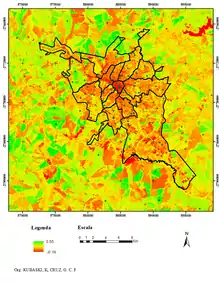
It can be seen from its mathematical definition that the NDVI of an area containing a dense vegetation canopy will tend to positive values (say 0.3 to 0.8) while clouds and snow fields will be characterized by negative values of this index. Other targets on Earth visible from space include:
- free standing water (e.g., oceans, seas, lakes and rivers) which have a rather low reflectance in both spectral bands (at least away from shores) and thus result in very low positive or even slightly negative NDVI values,
- soils which generally exhibit a near-infrared spectral reflectance somewhat larger than the red, and thus tend to also generate rather small positive NDVI values (say 0.1 to 0.2).
In addition to the simplicity of the algorithm and its capacity to broadly distinguish vegetated areas from other surface types, the NDVI also has the advantage of compressing the size of the data to be manipulated by a factor 2 (or more), since it replaces the two spectral bands by a single new field (eventually coded on 8 bits instead of the 10 or more bits of the original data).
The NDVI has been widely used in applications for which it was not originally designed. Using the NDVI for quantitative assessments (as opposed to qualitative surveys as indicated above) raises a number of issues that may seriously limit the actual usefulness of this index if they are not properly addressed. The following subsections review some of these issues.
- Mathematically, the sum and the difference of the two spectral channels contain the same information as the original data, but the difference alone (or the normalized difference) carries only part of the initial information. Whether the missing information is relevant or valuable is for the user to judge, but it is important to understand that an NDVI product carries only a fraction of the information available in the original spectral reflectance data.
- Users of NDVI have tended to estimate a large number of vegetation properties from the value of this index. Typical examples include the Leaf Area Index, biomass, chlorophyll concentration in leaves, plant productivity, fractional vegetation cover, accumulated rainfall, etc. Such relations are often derived by correlating space-derived NDVI values with ground-measured values of these variables. This approach raises further issues related to the spatial scale associated with the measurements, as satellite sensors always measure radiation quantities for areas substantially larger than those sampled by field instruments. Furthermore, it is of course illogical to claim that all these relations hold at once, because that would imply that all of these environmental properties would be directly and unequivocally related between themselves.
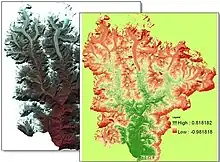 Generated Normalized Difference Vegetation Index (NDVI) from the satellite images
Generated Normalized Difference Vegetation Index (NDVI) from the satellite images - The reflectance measurements should be relative to the same area and be acquired simultaneously. This may not be easy to achieve with instruments that acquire different spectral channels through different cameras or focal planes. Mis-registration of the spectral images may lead to substantial errors and unusable results.
Also, the calculation of the NDVI value turns out to be sensitive to a number of perturbing factors including
- Atmospheric effects: The actual composition of the atmosphere (in particular with respect to water vapor and aerosols) can significantly affect the measurements made in space. Hence, the latter may be misinterpreted if these effects are not properly taken into account (as is the case when the NDVI is calculated directly on the basis of raw measurements).
- Clouds: Deep (optically thick) clouds may be quite noticeable in satellite imagery and yield characteristic NDVI values that ease their screening. However, thin clouds (such as the ubiquitous cirrus), or small clouds with typical linear dimensions smaller than the diameter of the area actually sampled by the sensors, can significantly contaminate the measurements. Similarly, cloud shadows in areas that appear clear can affect NDVI values and lead to misinterpretations. These considerations are minimized by forming composite images from daily or near-daily images.[12] Composite NDVI images have led to a large number of new vegetation applications where the NDVI or photosynthetic capacity varies over time.
- Soil effects: Soils tend to darken when wet, so that their reflectance is a direct function of water content. If the spectral response to moistening is not exactly the same in the two spectral bands, the NDVI of an area can appear to change as a result of soil moisture changes (precipitation or evaporation) and not because of vegetation changes.
- Anisotropic effects: All surfaces (whether natural or man-made) reflect light differently in different directions, and this form of anisotropy is generally spectrally dependent, even if the general tendency may be similar in these two spectral bands. As a result, the value of NDVI may depend on the particular anisotropy of the target and on the angular geometry of illumination and observation at the time of the measurements, and hence on the position of the target of interest within the swath of the instrument or the time of passage of the satellite over the site. This is particularly crucial in analyzing AVHRR data since the orbit of the NOAA platforms tended to drift in time. At the same time, the use of composite NDVI images minimizes these considerations and has led to global time series NDVI data sets spanning more than 25 years.
- Spectral effects: Since each sensor has its own characteristics and performances, in particular with respect to the position, width and shape of the spectral bands, a single formula like NDVI yields different results when applied to the measurements acquired by different instruments.
- Modifiable areal unit problem (MAUP): NDVI is ubiquitous as an index of vegetation. Since mapping and monitoring of vegetation takes place via ‘big data’ image processing systems. These systems may use pixel- or object-based algorithms to assess vegetation health, evapotranspiration, and other ecosystem functions. When a category of vegetation consists of multiple pixels, the calculation of a ‘mean’ can be a mean of NDVI values for each pixel (pixel-based), or a mean of the Red values and a mean of the NIR values for all the pixels in which the mean NDVI is the ratio of these (object-based). NDVI can suffer from the intractable problems that are associated with MAUP. In particular, a recent study demonstrated that when NDVI mean values are estimated for certain buffer distances, the scale of the analysis can influence NDVI measures due to the presence of scale effects associated with MAUP.[13] Another study demonstrated that MAUP does not significantly impact in case of pure vegetation pixels in an urban environment.[14] A modification known as MAUI-NDVI specifically addresses the problem.[15]
A number of derivatives and alternatives to NDVI have been proposed in the scientific literature to address these limitations, including the Perpendicular Vegetation Index,[16] the Soil-Adjusted Vegetation Index,[17] the Atmospherically Resistant Vegetation Index[18] and the Global Environment Monitoring Index.[19] Each of these attempted to include intrinsic correction(s) for one or more perturbing factors. A current alternative adopted by USGS is the enhanced vegetation index (EVI), correcting for soil effects, canopy background, and aerosol influences.[20]
It is not until the mid-1990s, however, that a new generation of algorithms were proposed to estimate directly the biogeophysical variables of interest (e.g., the fraction of absorbed photosynthetically active radiation, FAPAR), taking advantage of the enhanced performance and characteristics of modern sensors (in particular their multispectral and multiangular capabilities) to take all the perturbing factors into account. In spite of many possible perturbing factors upon the NDVI, it remains a valuable quantitative vegetation monitoring tool when the photosynthetic capacity of the land surface needs to be studied at the appropriate spatial scale for various phenomena.
Agriculture Applications
Within precision agriculture, NDVI data provides a measurement of crop health. Today, this often involves agricultural drones, which are paired with NDVI to compare data and recognize crop health issues. One example of this is agriculture drones from PrecisionHawk and Sentera, which allow agriculturalists to capture and process NDVI data within one day, a change from the traditional NDVI uses and their long lag times.[21] Much of the research done currently has proved that the NDVI images can even be obtained using the normal digital RGB cameras by some modifications in order to obtain the results similar to those obtained from the multispectral cameras and can be implemented effectively in the crop health monitoring systems.
Recently, mobile applications using NDVI data as crop health monitoring tools have proliferated. Mobile applications such as Doktar's Orbit provide NDVI data within health maps to detect any anomalies in the farmer's field. These applications aim to digitalize farming and introducing new ways of field scouting. NDVI-based remote field monitoring tools allow farmers to save fuel costs as these tools reduce field visits and enable better irrigation management.
Landsat 8, Sentinel-2 and PlanetScope are some of the main providers of satellite imagery to make NDVI maps and monitor crop health.
Notes
- "Measuring Vegetation (NDVI & EVI)". 2000-08-30.
- "NDVI from First Principles".
- Data downloaded from Australian Bureau of Meteorology on 13 June 2018, mapped in R. 14 June 2018
- Rouse, J.W, Haas, R.H., Scheel, J.A., and Deering, D.W. (1974) 'Monitoring Vegetation Systems in the Great Plains with ERTS.' Proceedings, 3rd Earth Resource Technology Satellite (ERTS) Symposium, vol. 1, p. 48-62. https://ntrs.nasa.gov/citations/19740022614
- Kriegler, F.J., Malila, W.A., Nalepka, R.F., and Richardson, W. (1969) 'Preprocessing transformations and their effects on multispectral recognition.' Proceedings of the Sixth International Symposium on Remote Sensing of Environment, p. 97-131.
- Gates, David M. (1980) Biophysical Ecology, Springer-Verlag, New York, 611 p.
- "Measuring Vegetation". NASA Earth Observatory. 2000-08-30.
- Crippen, R.E. (1990) 'Calculating the vegetation index faster,' Remote Sensing of Environment, 34, 71-73.
- Sellers, P. J. (1985) 'Canopy reflectance, photosynthesis, and transpiration', International Journal of Remote Sensing, 6, 1335-1372.
- Myneni, R. B., F. G. Hall, P.J. Sellers, and A.L. Marshak (1995) 'The interpretation of spectral vegetation indexes', IEEE Transactions on Geoscience and Remote Sensing, 33, 481-486.
- Kubaski, Kauan Mateus. "Urban Climate: surface temperature and NDVI an analysis of influences in Ponta Grossa-PR" (PDF) (in Brazilian Portuguese). UEPG (Pro-rector of Research and Post-graduation-PROPESP). Archived from the original (PDF) on July 9, 2019. Retrieved September 10, 2018.
- Holben, B. N. (1986)'Characteristics of Maximum-Value Composite Images from Temporal AVHRR Data', International Journal of Remote Sensing, 7(11), 1417-1434.
- Labib, SM; Lindley, Sarah; Huck, Jonny J. (July 2020). "Scale effects in remotely sensed greenspace metrics and how to mitigate them for environmental health exposure assessment". Computers, Environment and Urban Systems. 82: 101501. doi:10.1016/j.compenvurbsys.2020.101501.
- Nouri, Hamideh; Anderson, Sharolyn; Sutton, Paul; Beecham, Simon; Nagler, Pamela; Jarchow, Christopher J.; Roberts, Dar A. (April 2017). "NDVI, scale invariance and the modifiable areal unit problem: An assessment of vegetation in the Adelaide Parklands". Science of the Total Environment. 584–585: 11–18. Bibcode:2017ScTEn.584...11N. doi:10.1016/j.scitotenv.2017.01.130. PMID 28131936.
- Nouri, Hamideh; Anderson, Sharolyn; Sutton, Paul; Beecham, Simon; Nagler, Pamela; Jarchow, Christopher J.; Roberts, Dar A. (15 April 2017). "NDVI, scale invariance and the modifiable areal unit problem: An assessment of vegetation in the Adelaide Parklands". Science of the Total Environment. 584–585: 11–18. Bibcode:2017ScTEn.584...11N. doi:10.1016/j.scitotenv.2017.01.130. PMID 28131936.
- Richardson, A. J. and C. L. Wiegand (1977) 'Distinguishing vegetation from soil background information', Photogrammetric Engineering and Remote Sensing, 43, 1541-1552.
- Huete, A. R. (1988)'A soil-adjusted vegetation index (SAVI)', Remote Sensing of Environment, 25, 53-70.
- Kaufman, Y. J. and D. Tanre (1992) 'Atmospherically resistant vegetation index (ARVI) for EOS-MODIS', in 'Proc. IEEE Int. Geosci. and Remote Sensing Symp. '92, IEEE, New York, 261-270.
- Pinty, B.; Verstraete, M. M. (1992). "GEMI: a non-linear index to monitor global vegetation from satellites". Vegetatio. Springer Nature. 101 (1): 15–20. doi:10.1007/bf00031911. ISSN 0042-3106. S2CID 32216977.
- A. Huete, K. Didan, T. Miura, E. P. Rodriguez, X. Gao, L. G. Ferreira. Overview of the radiometric and biophysical performance of the MODIS vegetation indices. Remote Sensing of Environment 83(2002) 195-213 doi:10.1016/S0034-4257(02)00096-2.
- Lyseng, Ron (2 February 2017). "Sentera links processor with sensor for live NDVI". Western Producer.
References
- Deering, D.W. 1978. Rangeland reflectance characteristics measured by aircraft and spacecraft sensors. Ph.D. Diss. Texas A&M Univ., College Station, 338p.
- Deering D.W., J.W. Rouse, Jr., R.H. Haas, and J.A. Schell. 1975. Measuring "forage production" of grazing units from Landsat MSS data, pp. 1169–1178. In Proc. Tenth Int. Symp. on Remote Sensing of Environment. Univ. Michigan, Ann Arbor.
- Rouse, J.W., Jr., R.H. Haas, J.A. Schell, and D.W. Deering. 1973. Monitoring the vernal advancement and retrogradation (green wave effect) of natural vegetation. Prog. Rep. RSC 1978-1, Remote Sensing Center, Texas A&M Univ., College Station, 93p. (NTIS No. E73-106393)
- Rouse, J. W., R. H. Haas, J. A. Schell, and D. W. Deering (1973) 'Monitoring vegetation systems in the Great Plains with ERTS', Third ERTS Symposium, NASA SP-351 I, 309-317.
- Tucker, C.J. (1979) 'Red and Photographic Infrared Linear Combinations for Monitoring Vegetation', Remote Sensing of Environment, 8(2),127-150.